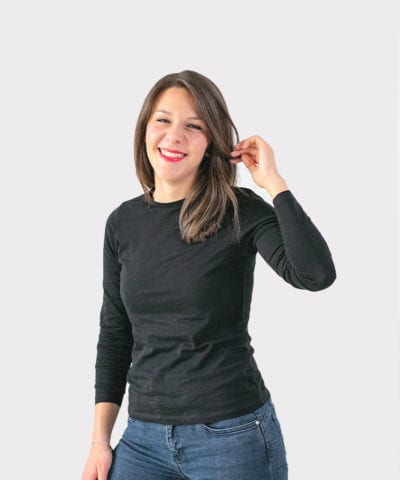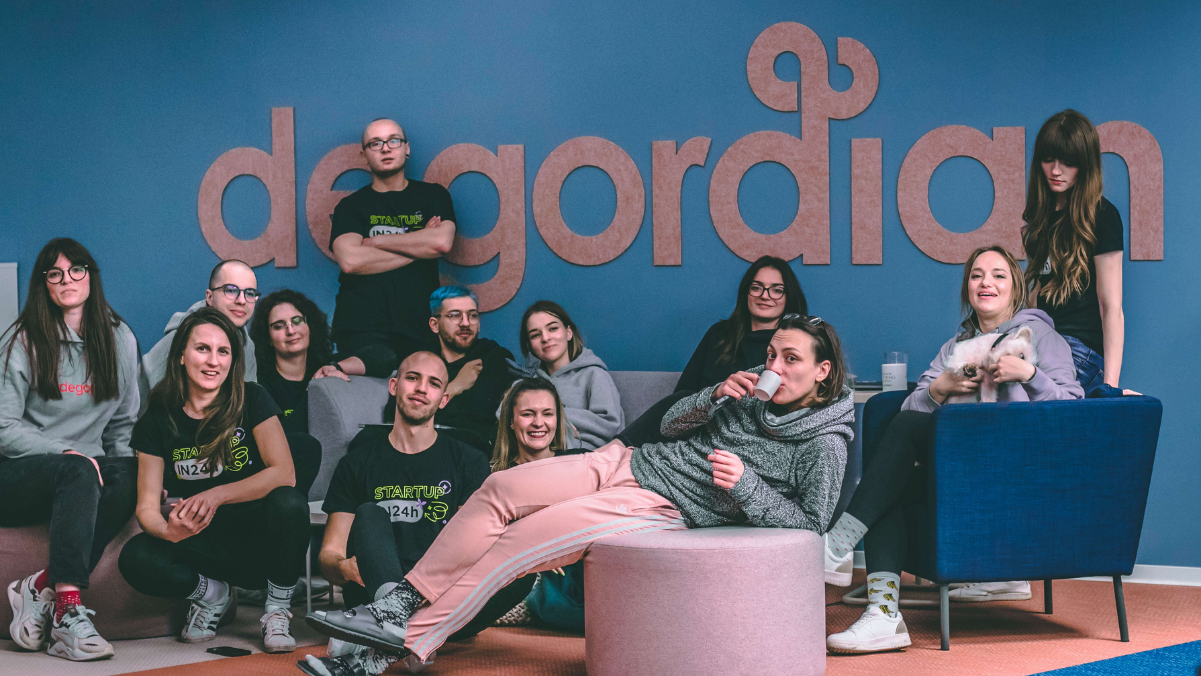The pandemic and subsequent lockdown had some unusual benefits. Work from home was one of them — which is why we decided to make it stay.
The COVID-19 pandemic has completely changed the way we go about our usual social gatherings, which also includes business activities in offices. The new circumstances set in motion a slew of new practices in companies, who had to go through changes that were simply necessary.
That’s why we at Degordian currently work in our office only when it’s absolutely necessary for business reasons, and all other communication, collaboration and everyday tasks are adjusted so we can do them from any location.
First of all, I think this sends a message to employees that management is thinking of health safety and taking priority in getting things done, instead of where they are done. Second of all, I think we all recently learned a lot about how to balance personal and work lives, and figured that we haven’t been managing time so efficiently before the pandemic.
I’m excited to share with you how and when we decided to involve more flexibility into our workplace and what we plan to do in the future!
New challenges are also new opportunities
Due to the general lockdown, we all found ourselves in a completely new situation — we were all working from home and doing our usual tasks, but without the usual people around us, resulting in a change in the existing dynamic and cooperation.
The first few days were really challenging since we needed to figure out how to get all the work done, stay in contact with colleagues and clients, but also get some much-needed rest. We were even slightly afraid of the results — although we introduced a support system for all employees, it was still completely new territory.
The good thing was that it became obvious that everyone has a clear vision of their role in the company and a uniting goal, proving that if the team is tightly woven, a marketing agency can function even with employees working at different locations (sometimes even far away from each other).
During that period we started talking about things we could try in the future and about what we’ve learned or were learning at that time, and that was where the initial idea of increased long-term workplace flexibility came from.
If you’re doing something for employees, ask them about their opinion
Since we already have experience with creating employee satisfaction surveys, we decided to conduct another one, this time regarding remote work satisfaction. The questions ranged from general commentary about liking or disliking working from home to specific questions about productivity, communication with coworkers, task organization, perceived support from the agency, etc. The key questions were these: what do employees momentarily see as advantages of the work from home scenario, and what they think are its disadvantages.
The interesting thing is, all answers about the disadvantages had similar notions. They talked about the lack of social contact, missing the spontaneity of office talk and the possibility of directly communicating and sharing info more easily, as well as a harder time dividing and defining work hours and personal time. Those were all topics that hinted at problems that were solvable or something we can work on in the future.
On the other hand, the benefits were various and strong in number, and people said that they truly mean a lot. They included saving time on commute, easier time-management of other personal obligations, better concentration, longer and better sleep, fresh homemade food, more time spent with family, etc. This gave us extra proof that we were moving in the right direction, and that we should keep considering the possibility of a flexible workplace, but also think about how to solve or diminish its disadvantages.

After a month, we had a new survey about the desire and interest to go back to our office. By that point, many were considering not only working from their homes in Zagreb, but also from their vacation homes, beach houses or faraway hometowns.
Half of Degordian employees expressed their wish to continue working remotely. Slightly less than 50% said that they want to have the option to work from home a few days in the week, but also spend some days in the office.
It was hugely useful to know the reasons why some people wanted to work remotely and others from the office. It gave us the chance to consider if the reason was of private nature or business-related, and whether or not we could work with the motivation that was business-related.
It was also important to know the answer to the question “if we continue working from home, what are your expectations of Degordian?” It was useful in that short period, but also served as the foundation for work models that we formed later on.
Look into knowledge from the outside and experiences of other companies
Since remote work was a hot subject everywhere in the world, we looked into the experiences of others. There are companies that had remote employees even before the pandemic and who really benefited from the model. There are also companies that introduced a flexible workplace, then recalled their decision (for example, Yahoo!). These are all valuable pieces of knowledge that can help you learn from the mistakes and good practices outside of your company.
For me personally, the biggest insight out of everything I’ve read was that this isn’t a one size fits all situation. What works for others might not work for you, since every business is different and each management has its specific ways of doing things, and every team handles new practices differently. The conclusion is: there is no universal solution that works for everyone, so it’s important to develop your own work model with the knowledge about the specific company and people who make it.
The other big conclusion I had was this: we should focus on actually making remote work function, instead of just asking ourselves if we should even attempt it.
Look into the needs of your company and the specifics of your business
In order to get a better idea on how to create a new model of work at Degordian, we formed a small task force of people from different teams and positions so we could get diverse perspectives on the issue. The team consisted of people from our Human Resources and Project Management departments, as well as one person who has been in the agency for 6 years and has excellent knowledge of its culture and people.
This proved to be a good combination — together we could get a better outlook on the specific characteristics of our company, could imagine more “what if” scenarios and figure out how to solve those imagined situations. The involvement of our CEO was also crucial. He was the one who opened up the flexible workplace discussion in the first place, and he gave us immediate feedback on all ideas, as well as pointers on what to do next.
It’s wise to start with a pilot project
We knew right from the start that whatever we created would surely be altered according to insights we gained on the way, and we knew that we should tell that to other employees so they could know what to expect.
That’s why we decided to announce our flexible workplace model as a pilot project. We have offices in Zagreb, Mostar and Beograd, but we decided that the pilot would start with our headquarters.
The duration of the pilot was set to be 3 months, which we consider an optimal amount of time to see what the benefits and challenges are, as well as for everyone to form an opinion about the project so they can give us feedback.
As for workplace flexibility, we came up with 3 models of work at Degordian:
- the first model
A person works primarily in the office, has a permanent spot in the office area, but can use up to 5 days per month to work from somewhere else (if he or she wants to). This is great for people who prefer working in the office and who function better in that kind of atmosphere. - the second model
A person is flexible and can choose where he/she wants to work, but doesn’t have a fixed spot in the office and sits at desks that are available. The person has to work from the office 1 to 3 days per week (depending on their responsibilities, the exact number of days is arranged with the department leader), as well as days when the job exceptionally requires that person’s presence in the office. Other days of the week the person is totally flexible to work wherever, which is great for those who want to pick & choose or thrive in their personal and professional lives when given more freedom. - the third model
A person works primarily outside the office, doesn’t have a permanent desk and only comes because of certain business activities or group gatherings of everyone at Degordian. This is an excellent choice for people who are interested in living outside of cities where our offices are.

All three workplace models are currently in consideration. After the pilot project ends, we’ll see how every model performed and which ones we should keep and/or further develop. Plus, we already figured out that all models are not applicable for all positions (and levels of responsibility), so we’ll surely work on that. This is a project that will take some time to become stable and permanent, and we’re totally okay with that. 🙂
Investing in the future
I believe that more flexibility regarding the workplace will have huge benefits for Degordian. That’s why the current perspective is not whether we want to keep these models or not, but how to develop and make them better.
The initial model is here, but what follows is investing time and making adjustments where necessary. These are some of the areas I think Degordian should keep upgrading, as well as any other company that decides to develop a more flexible, work-from-home environment:
- Good communication
Communication is the bloodstream of an organization. When it’s good as it should be, it allows every employee to have clear expectations, which is the foundation of genuine cooperation. Companies can and should stimulate better communication skills in their employees, encourage giving feedback and inspire open communication. When people are working from different locations (and maybe even have different schedules), an uninterrupted flow of information is crucial for a job well done. - Going digital and going online where we can
Having employees in separate locations requires a change of mindset — everything that used to be held in the office now needs to be available to everyone, everywhere. That means digitalization and going online, making sure that all have access to meetings, education, brainstorm sessions, 1 on 1 meetings, department meetings, etc. Also, everything related to the job that used to be communicated live must now also be written down, so everyone has access to necessary information, no matter where they are. - Solution-oriented mindset
Employees are no longer alongside one another during the workday, which means they may come up with challenging situations that won’t be possible to solve just by walking up to a colleague and sorting it out straight away. They will need to dedicate certain time in their schedule to deal with the problem, so it’s necessary to encourage a solution-oriented mindset and to make sure that everyone is focused on fixing issues and moving on, and not lingering on problems. - Employee well-being
Until now, working in an office had certain well-being benefits. For example, if you’re having a hard day or a difficult task, just a 5 minute chat with a coworker can help you relax or lift your spirits. Or you can maybe use your break to walk around the office with a colleague, fulfilling your needs for social interaction, physical movement and emotional support. The “new normal” means our coworkers are no longer with us every day, so it’s essential to introduce new support systems, ones that will make remote employees feel those same well-being benefits as before. - Comfortable chairs for people working outside the office
Remote work is here to stay, and we’ll probably never go back to working 100% from the office. But we shouldn’t forget the one thing that stays the same wherever we go — we all spend a lot of time sitting. Protecting your back is always a must, which is why investing in a high-quality, comfy chair is always a good idea, no matter where you’re working from. 🙂

In my opinion, the circumstances of the past few months caused irrevocable change. The pandemic made a lot of companies realize how vulnerable they are, and adapting businesses to WFH models makes them more resistant to future scenarios similar to the COVID-19 outbreak. We can definitely say that the one good thing this big “social experiment” showed us was that it’s justified to believe in remote work and that it truly can function, it just needs to be set up correctly.
I’ve heard repeatedly that those who profit the most are those who adapt to new circumstances, and those who go against the current of changes will probably drown. I couldn’t agree more!
Now what’s left is seeing all the facets of these flexible work models and their effect on Degordian, but we’re ready to learn, adapt and figure out new solutions along the way.




